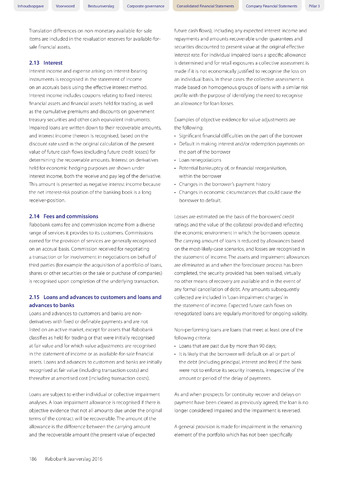Inhoudsopgave Voorwoord Bestuursverslag Corporate governance
Translation differences on non-monetary available-for-sale
items are included in the revaluation reserves for available-for-
sale financial assets.
2.13 Interest
Interest income and expense arising on interest-bearing
instruments is recognised in the statement of income
on an accruals basis using the effective interest method.
Interest income includes coupons relating to fixed interest
financial assets and financial assets held for trading, as well
as the cumulative premiums and discounts on government
treasury securities and other cash equivalent instruments.
Impaired loans are written down to their recoverable amounts,
and interest income thereon is recognised, based on the
discount rate used in the original calculation of the present
value of future cash flows (excluding future credit losses) for
determining the recoverable amounts. Interest on derivatives
held for economic hedging purposes are shown under
interest income, both the receive and pay leg of the derivative.
This amount is presented as negative interest income because
the net interest-risk position of the banking book is a long
receiver-position.
2.14 Fees and commissions
Rabobank earns fee and commission income from a diverse
range of services it provides to its customers. Commissions
earned for the provision of services are generally recognised
on an accrual basis. Commission received for negotiating
a transaction or for involvement in negotiations on behalf of
third parties (for example the acquisition of a portfolio of loans,
shares or other securities or the sale or purchase of companies)
is recognised upon completion of the underlying transaction.
2.15 Loans and advances to customers and loans and
advances to banks
Loans and advances to customers and banks are non-
derivatives with fixed or definable payments and are not
listed on an active market, except for assets that Rabobank
classifies as held for trading or that were initially recognised
at fair value and for which value adjustments are recognised
in the statement of income or as available-for-sale financial
assets. Loans and advances to customers and banks are initially
recognised at fair value (including transaction costs) and
thereafter at amortised cost (including transaction costs).
Loans are subject to either individual or collective impairment
analyses. A loan impairment allowance is recognised if there is
objective evidence that not all amounts due under the original
terms of the contract will be recoverable. The amount of the
allowance is the difference between the carrying amount
and the recoverable amount (the present value of expected
Consolidated Financial Statements Company Financial Statements Pillar 3
future cash flows), including any expected interest income and
repayments and amounts recoverable under guarantees and
securities discounted to present value at the original effective
interest rate. For individual impaired loans a specific allowance
is determined and for retail exposures a collective assessment is
made if it is not economically justified to recognise the loss on
an individual basis. In these cases the collective assessment is
made based on homogenous groups of loans with a similar risk
profile with the purpose of identifying the need to recognise
an allowance for loan losses.
Examples of objective evidence for value adjustments are
the following:
Significant financial difficulties on the part of the borrower
Default in making interest and/or redemption payments on
the part of the borrower
Loan renegotiations
Potential bankruptcy of, or financial reorganisation,
within the borrower
Changes in the borrower's payment history
Changes in economic circumstances that could cause the
borrower to default.
Losses are estimated on the basis of the borrowers'credit
ratings and the value of the collateral provided and reflecting
the economic environment in which the borrowers operate.
The carrying amount of loans is reduced by allowances based
on the most-likely-case scenarios, and losses are recognised in
the statement of income. The assets and impairment allowances
are eliminated as and when the foreclosure process has been
completed, the security provided has been realised, virtually
no other means of recovery are available and in the event of
any formal cancellation of debt. Any amounts subsequently
collected are included in 'Loan impairment charges' in
the statement of income. Expected future cash flows on
renegotiated loans are regularly monitored for ongoing validity.
Non-performing loans are loans that meet at least one of the
following criteria:
Loans that are past due by more than 90 days;
It is likely that the borrower will default on all or part of
the debt (including principal, interest and fees) if the bank
were not to enforce its security interests, irrespective of the
amount or period of the delay of payments.
As and when prospects for continuity recover and delays on
payment have been cleared as previously agreed, the loan is no
longer considered impaired and the impairment is reversed.
A general provision is made for impairment in the remaining
element of the portfolio which has not been specifically
186 Rabobank Jaarverslag 2016

